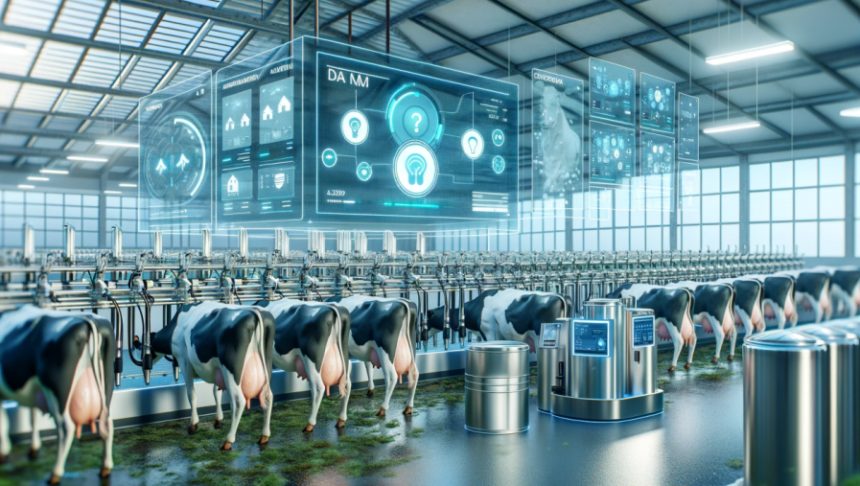The application of artificial intelligence (AI) is indeed worthwhile in transforming the world and its livestock-based food production systems.Such technologies are fueling a new wave of innovations, benefiting everyone anddriving the dairy sector towards a sustainable future.The dairy industry has been an integral part of the Indian economy for decades. India has been the leading producer and consumer of dairy products worldwide since 1998 with a sustained growth.
India is the largest producer of milk and ranked 1st contributing to 25 per cent of global milk output. Milk production in the country has reached to 239.20 million tones, amounting approximatelyRs.11.16 lakh crore during 2022-23 (As per National Accounts Statistics 2024) which is the highest of the agriculture produce and even more than the combined value of wheat and paddy.
Dairying, in the present time occupies a special niche among all other sectors as it plays a significant role in uplifting the socio-economic status, contributing significantly to the nation’s GDP, along-with providing direct employment opportunities to more than 8 crore farmers in our country and helping in asset creation. The dairy industry in India is currently facing high demand for productivity, sustainability and animal welfare. To remain profitable, the sector needs to embrace new technologies and innovations. In this context, artificial intelligence (AI) has the potential to offer a new vision of dairying and a representative example for other dairy farming communities around the globe.
Artificial Intelligence (AI) is one of the most exciting technological innovations of this century. Fascinating as much as scary it is, AI-driven technology has entered our lives. Starting from Apple’s Siri, Amazon’s Alexa, Google Assistant, we human beings have an easy access to a variety of AI-powered virtual assistants and thus the use of AI has made our life easier and smarter. It is not just a tool but a game-changer, significantly improving accuracy and efficiency.
The applications of artificial intelligence are endless, be it in banking, marketing or agriculture allied sectors, thus revolutionizing the way we live, work and how we produce, distribute and consume food.On global scale theAI market size was 638.23 billion USD in 2024, calculated at 638.23 billion USD in 2025 and is expected to reach around 3,680.47 billion USD by 2034, with forecasted expansion of19.20% (CAGR) from 2025 to 2034.
Digital dairying is not just about technology but about turning data into valuable insights that can significantly increase cow health, ensure disease free production systems, profitability and output. Such innovationsare making data-driven choices a reality and enabling farmers to maximize both animal welfare and commercial results.Such cutting edge solutions offer unparalleled potential in improving efficiency, productivity and overall management of supply chain systems.
Computers are being used to mimic human learning and thought; and to process and analyse vast amounts of data in real-time, providing valuable insights and enabling data-driven decision-making for farmers. Such technologies are based on harnessing the power of machine learning, deep learning, natural language processing and data analytics.It’s about empowering farmers to uncover trends and prospects that conventional wisdom might overlook.
Artificial intelligence (AI) has become a game changer in modern-day dairying, imagining a dairy farm where technology controls feeding schedules, forecasting cow health and maximizing milk output without continual human supervision, is no exception to this trend.
Innovations ranging from robotic milking systems; robotic feeding and dairy barn cleaning; use of smart drones providing better monitoring of the herd by way of detecting any abnormal behaviour related to lameness, illness and calving, etc; sensors are being used to monitor health of dairy cows (temperature check, heat detection, calving, locomotion distress, monitor rumination and detect issues related to ruminal acidosis, etc); now-a-days bio-sensors are being used for monitoring variety of contaminants like pesticides, aflatoxin, drug residues, heavy metals and microbial pathogens in dairy foods.
With the advent of 3D printing, wherein manufacturers can design and fabricate the dairy products with customized shape, colour, flavour and tailor-made nutritional needs.The application of Virtual Reality (VR) in dairying has positive impact on milk production by way of creating a favourable environment, where the animals can visualize lush green pastures thus decreasing their anxiety and increasing the overall emotion of the cows.
With the introduction of blockchain technology, the consumers can now connect all the aspects of the supply chain starting from the farm to the fork. It helps in traceability of the products, food safety issues and transparency and thus increases the trust of the consumers towards the dairy industry. Last but not the least, with the introduction of artificial neural networks (ANN) the prediction of shelf life of yoghurt, processed cheese, kalakand, burfi, etc has been initiated.
As dairying navigates this digital transformation, there is a debate about the advantages outweighing its disadvantages. The contribution and benefits of such innovations are although significant for humankind butthere are certain issues that require deeper consideration.The journey toward integrating artificial intelligence into dairying is more than a technological endeavor; it requires a collective pursuit on the part of policy makers, industry, academia and farming communities.
Collaborative efforts are crucial fordeveloping affordable and accessible solutions with awidespread adoption and ultimately bridging the digital divide. Policies supporting technological integration and continuous research are vital to achieve new levels of sustainability and productivity.
Despite its powerful, analytical and predictive capabilities, artificial intelligence (AI) is not a cure-all. It should enhance, not replace, human judgment and traditional knowledge. A balanced approach is the key, blending innovation with practicality, offering opportunities to maximize AI’s potential in dairying and animal welfare.
(The Author is Veterinary Assistant Surgeon, Gr-II AH Department, J&K. Feedback: [email protected])








